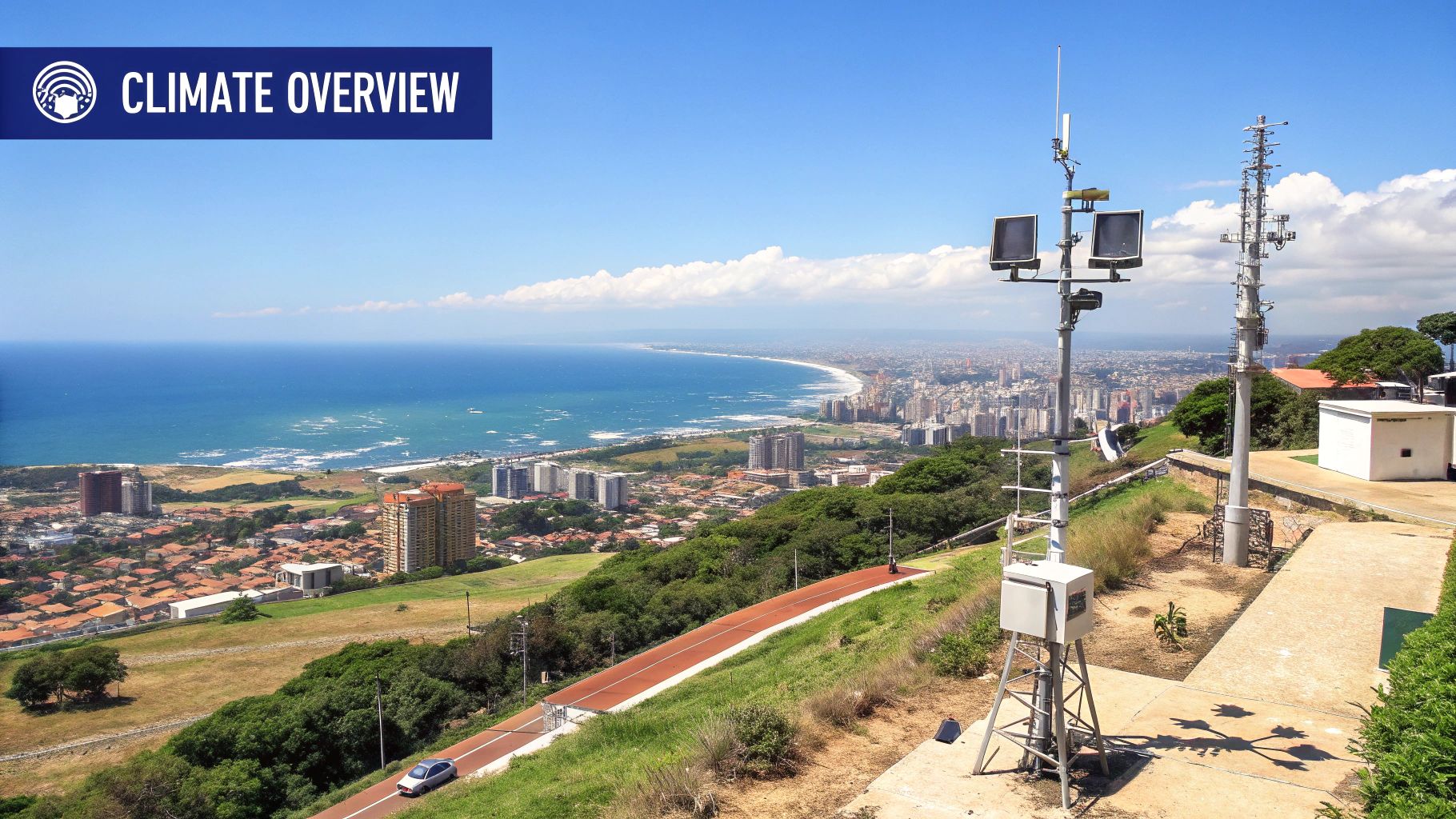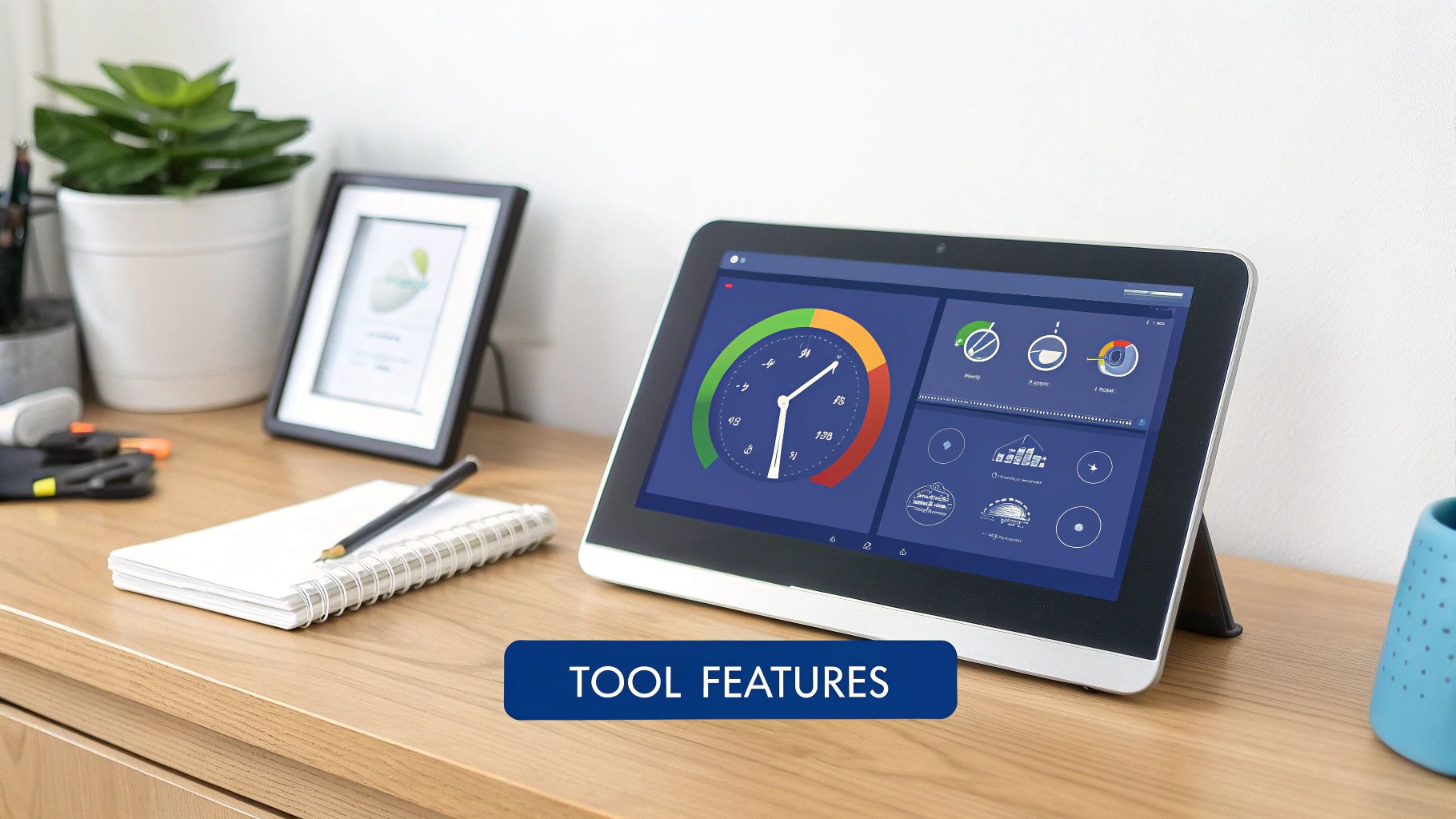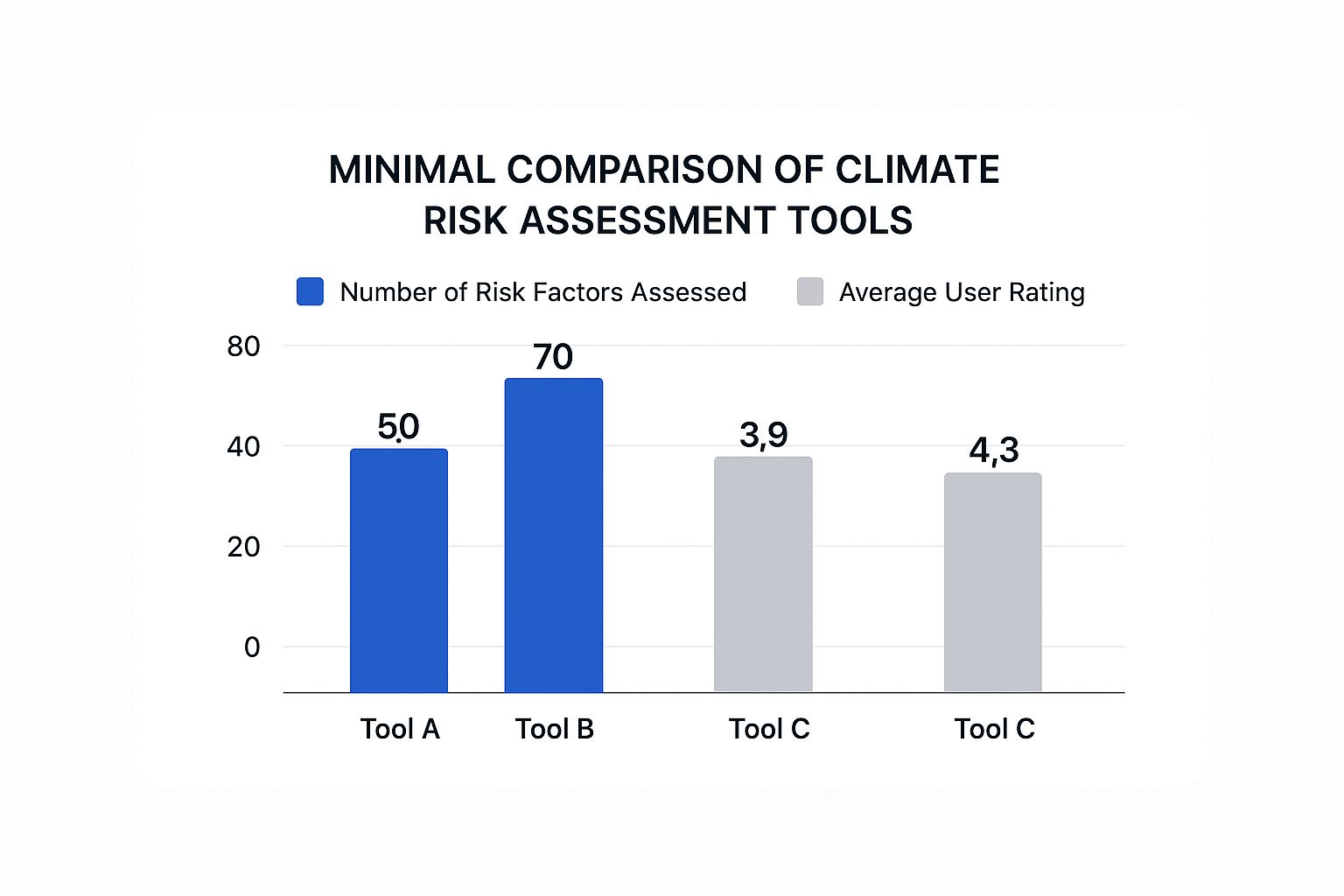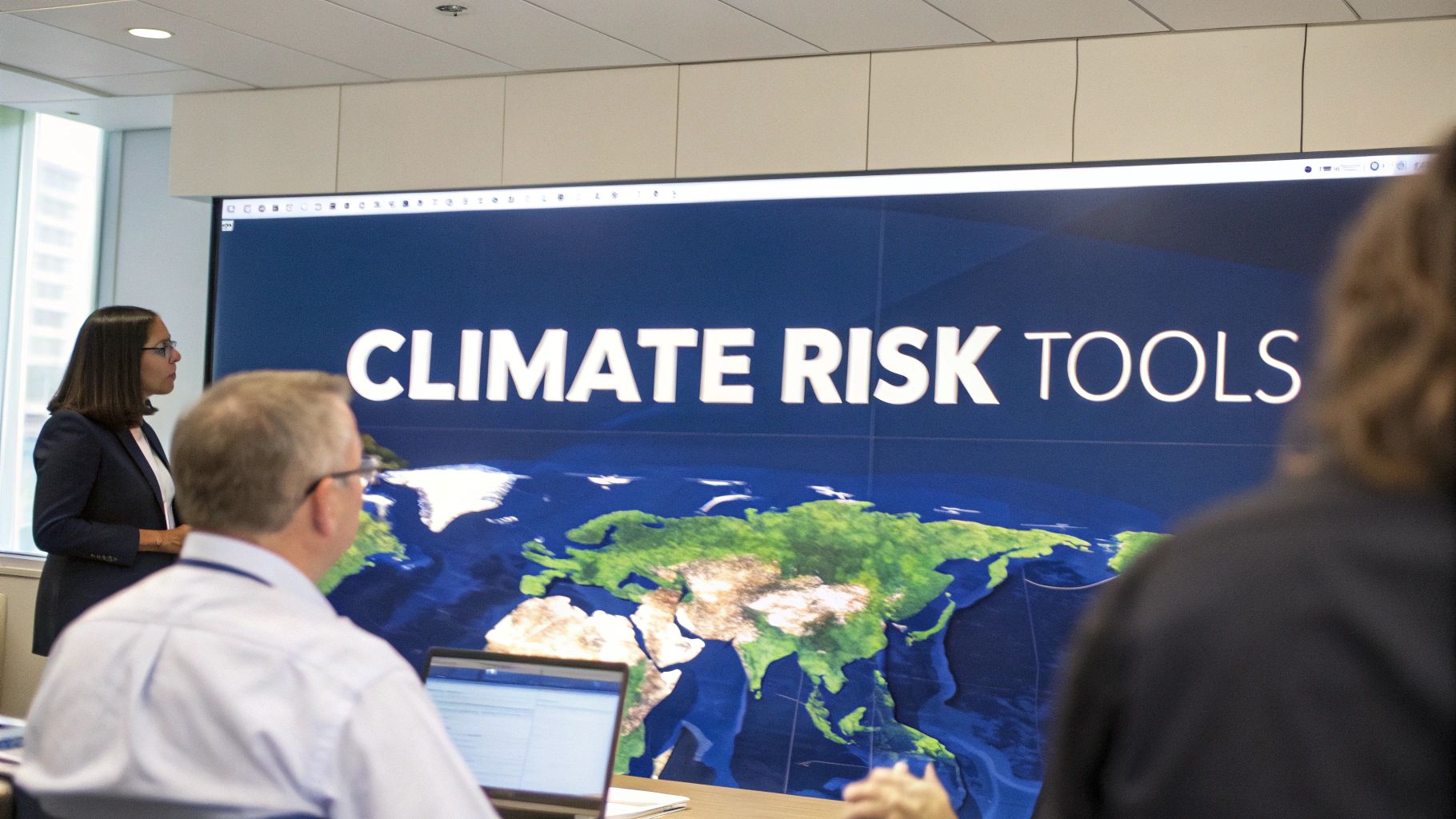For any Texas business leader, the challenge isn't just knowing that extreme weather is a threat. It's about turning abstract climate data into a tangible competitive advantage. This is where climate risk assessment tools are essential—they provide the data-driven foresight needed to shift from reactive crisis management to proactive operational planning, turning potential liabilities into a source of organizational strength.
Turn Climate Data Into Your Competitive Advantage

Here in Texas, the operational reality of extreme weather is undeniable. We've seen hurricanes impact Gulf Coast petrochemical plants, winter storms disrupt the power grid, and droughts affect agricultural yields in the Panhandle. For decision-makers, the financial and logistical stakes couldn't be higher.
That's why forward-thinking leaders in our core industries—Energy & Petrochemical, Manufacturing, Agriculture, Logistics, and Construction—are no longer just reacting. They're actively preparing. This preparation is being powered by a new class of climate risk assessment tools. These platforms deliver the foresight needed to make smarter, more resilient decisions, moving past vague warnings to give you specific, actionable intelligence on how extreme weather could impact your most critical assets.
From Abstract Threat to Actionable Insight
Think of these tools less like a weather forecast and more like an advanced diagnostic system for your business operations. They analyze how a specific climate hazard—such as a Category 4 hurricane, a ten-day heatwave, or a sudden deep freeze—would directly impact your physical assets and supply chain.
The real power of a climate risk assessment tool is its ability to translate complex climate science into quantifiable business metrics. This provides executives with the data needed to justify investments in resilience, strengthen supply chains, and mitigate operational risk before a crisis hits.
This capability is exactly why the market for these tools is expanding rapidly. The global climate risk assessment tools market, valued at approximately USD 5.15 billion, is projected to reach USD 48.21 billion by 2034. This growth is a clear indicator of how seriously businesses are taking the need to understand and manage their climate-related vulnerabilities. You can review the market projections to see the scale of this shift.
How Climate Risk Tools Benefit Key Texas Industries
For business leaders across the state, the applications are direct and powerful. The right platform can help your company do more than just survive an extreme weather event; it can help you maintain operational continuity and protect your bottom line.
The table below breaks down how these tools provide tangible advantages to the industries that form the backbone of the Texas economy.
| Industry Sector | Primary Climate Risk | Key Benefit of Assessment Tools |
|---|---|---|
| Energy & Petrochemical | Hurricanes & Extreme Temperatures | Fortify infrastructure, prevent production shutdowns, and improve asset-level preparedness. |
| Agriculture | Drought & Severe Storms | Optimize water management, plan for crop resilience, and protect livestock investments. |
| Manufacturing | Flooding & Power Outages | Secure supply chains, protect physical plants, and minimize operational downtime. |
| Logistics | Extreme Weather Disruptions | Reroute shipments proactively, identify vulnerable transport hubs, and maintain delivery schedules. |
| Construction | Flooding & High Winds | Assess site viability, protect equipment and materials, and mitigate project delays due to weather. |
By integrating these data-driven insights, Texas companies can move beyond simply reacting to the weather and start using climate intelligence to build more reliable and resilient operations.
Disclaimer: ClimateRiskNow provides educational information and tools for risk assessment. We do not sell insurance or offer financial advice. The content provided is for informational purposes only.
How Climate Risk Assessment Tools Actually Work

To make informed decisions, Texas business leaders need to understand what's happening "under the hood" of a climate risk assessment tool. These platforms function like a specialized GPS for business operations. A standard GPS combines satellite data, live traffic, and road maps to find the best route. These tools work on a similar principle, but with a different set of inputs.
They integrate global climate models, your company’s specific asset locations, and decades of historical weather data to forecast potential disruptions. This isn’t about generic warnings; it's about generating specific, localized threat intelligence for your actual facilities.
The Core Engine: Physical Risk Modeling
At their heart, these tools perform physical risk modeling. This process analyzes how direct weather events—like a hurricane, flash flood, or winter storm—could impact your physical assets. It’s not enough to know a hurricane is possible; it’s about modeling the specific financial and operational fallout for your Houston warehouse, your West Texas solar farm, or your Dallas distribution center.
The analysis works by layering multiple data sets:
- Asset-Level Data: This pinpoints the exact longitude and latitude of your critical facilities, from manufacturing plants to logistics hubs.
- Hazard Maps: High-resolution topographical and hydrological data is used to map vulnerabilities to events like floods, storm surges, and wildfires with precision.
- Historical Event Data: The system analyzes past events, like Hurricane Harvey or the 2021 winter storm, to model how a similar event today would affect your current operations.
A construction company, for instance, could use this modeling to see how a projected 5-inch rainfall event might impact a potential building site in Austin, identifying the exact low-lying areas most prone to flash flooding. That is the level of detail required for proactive risk management.
Looking Ahead: Transition Risk Analysis
Beyond immediate physical threats, modern tools also evaluate transition risks. These are the business challenges that arise as markets, regulations, and technologies shift in response to climate change. For Texas industries, understanding these risks is a critical component of long-term strategic planning.
Transition risk analysis helps you anticipate how regulatory shifts, new market demands, or changing investor expectations could impact your business model. It answers the question: "Are we prepared for the business climate of tomorrow?"
This analysis could model the financial impact of a new emissions-reporting mandate from the Texas Commission on Environmental Quality (TCEQ) or assess how evolving energy policies might affect an asset's profitability. It gives leaders a forward-looking view to ensure their business remains viable for the long term.
Data Visualization and Actionable Outputs
Finally, the best tools don’t just deliver raw data. They translate complex analysis into clear, intuitive outputs using advanced data visualization. This includes interactive maps, customizable dashboards, and reports that quantify potential financial losses and operational impacts.
For a logistics manager, this might be a map showing which of their primary routes along I-35 are most vulnerable to tornado-related disruptions. For an energy executive, it could be a timeline modeling heat-related stress on the power grid.
Clear visuals empower decision-makers to quickly grasp complex risks and take decisive action. Preparing for severe weather is an ongoing process, and a data-informed plan is non-negotiable. For a practical guide on getting started, review our comprehensive hurricane season preparation checklist.
Essential Features That Provide Actionable Insights
For Texas industries, generic, high-level climate data is of limited use. An effective climate risk assessment tool is defined by the quality and relevance of its features. Business leaders need specific functions that turn complex climate models into concrete, operational intelligence.
The right platform moves beyond raw data to deliver insights that drive action. It provides the tools to analyze threats specific to your assets, whether you're running a petrochemical plant on the Gulf Coast or managing a construction project in Dallas.
High-Resolution Hazard Mapping
One of the most critical features is high-resolution hazard mapping. This is far more precise than a standard county-level warning. It allows a business to see exactly how a physical hazard, like a flood or wildfire, could impact a specific facility address.
For instance, a plant manager in Houston could use this feature to see how a 500-year flood event would affect their site. By overlaying FEMA flood zones with high-resolution topographical data, the tool can pinpoint which buildings, storage yards, or access roads would be inundated. That is the data-driven evidence needed to justify targeted investments in flood barriers or asset relocation.
This level of detail is fundamental. It transforms a vague threat into a measurable, localized problem that can be proactively managed.
Here's a look at how different platforms stack up on key metrics, showing the clear link between analytical depth and user satisfaction.

As the data shows, platforms that assess more risk factors tend to deliver greater value, proving that a comprehensive analysis is what users really need.
Advanced Scenario Analysis
Another game-changing feature is scenario analysis. This allows you to model the financial and operational fallout from different climate futures and extreme weather events. It directly answers the critical business question: "What happens to our bottom line if this specific event occurs?"
For an energy company in West Texas, this might mean modeling the impact of a prolonged, severe heatwave. The tool could simulate:
- Reduced efficiency of power generation equipment under extreme heat.
- Increased strain on the electrical grid, raising the risk of blackouts.
- Potential revenue loss from production downtime and repair costs.
This kind of financial modeling gives executives the hard data they need to approve capital spending on grid modernization or heat-resistant infrastructure, making a clear business case for resilience investments.
Comparing Critical Features in Climate Risk Platforms
Not all tools are created equal. The table below breaks down essential features and what they mean in practical terms for a business operating in a high-risk environment like Texas.
A comparative look at essential features and their direct application for business decision-making in high-risk sectors.
| Feature | Description | Application for a Texas Business |
|---|---|---|
| High-Resolution Mapping | Asset-level analysis showing how hazards like floods or wildfires impact specific facility locations. | A Houston chemical plant identifies which storage tanks are in a 500-year flood plain and invests in targeted flood barriers. |
| Advanced Scenario Analysis | Financial modeling that quantifies the operational and revenue impact of various climate events. | A West Texas wind farm models revenue loss from turbine shutdowns during extreme heat, justifying an investment in upgraded cooling systems. |
| Supply Chain Mapping | Identifies climate risk exposure for critical suppliers, transportation routes, and logistics hubs. | A Dallas-based distributor reroutes shipments away from I-45 corridors prone to hurricane-related flooding. |
| Regulatory Reporting | Automates data collection for compliance reports (e.g., TCFD) to meet investor and regulatory demands. | A publicly traded construction firm in Austin generates a TCFD report, demonstrating proactive risk governance to shareholders. |
Ultimately, the goal is to connect a feature to a real-world decision. The right tool provides the clarity needed to protect assets, ensure operational continuity, and satisfy stakeholder expectations.
Supply Chain Vulnerability Mapping
A hard truth for any business: you are only as resilient as your supply chain. Modern climate risk tools now offer supply chain vulnerability mapping, extending your risk assessment beyond your own four walls. This feature lets you analyze the risk exposure of your critical suppliers, transportation routes, and logistics hubs.
A logistics firm in the Dallas-Fort Worth Metroplex could use this to see which key highway corridors, like I-35 or I-45, are most frequently shut down by tornadoes or flash floods. It can also flag the flood risk of a critical third-party warehouse near the Port of Houston, giving the company advance warning to diversify suppliers or create contingency routes. Integrating this into your overall strategy is vital; you can learn more about what is operational risk management in our detailed guide.
Key Takeaway: The ability to see and quantify risk across your entire value chain is no longer a "nice-to-have." It is a core component of building an enterprise that can withstand future climate-related disruptions.
Regulatory Compliance Reporting
With investors and regulators paying closer attention, the ability to generate compliance reports has become non-negotiable. Many platforms now come with modules built specifically for frameworks like the Task Force on Climate-related Financial Disclosures (TCFD).
These features automate the process of gathering and organizing climate risk data into standardized reports. For a publicly traded construction or energy company in Texas, this streamlines the disclosure of physical and transition risks to shareholders, demonstrating proactive governance and satisfying regulatory requirements. The trend is clear: climate risk analysis is becoming central to financial decision-making, a shift you can read more about in this detailed market report.
How To Select The Right Tool For Your Company
Choosing a climate risk assessment tool can feel overwhelming. Every vendor promises the best insights for your Texas operations, but how do you determine which platform truly delivers actionable intelligence? The key is not to jump straight into product demos. It starts with a thorough assessment of your own organization’s needs.
The goal is to find the platform with the right features for your specific risk profile. After all, a one-size-fits-all solution is a poor match for threats as localized as a flash flood in Austin, a hailstorm in the Panhandle, or a storm surge in Port Arthur.
Start With an Internal Needs Assessment
Before you evaluate any vendor, you must first map out what you need the tool to accomplish. This internal audit will serve as your scorecard for judging every potential solution.
Start by asking your operations, finance, and risk management leaders direct questions:
- Which assets are most critical to our revenue and operations? Pinpoint the specific facilities, infrastructure, or transportation hubs that would cripple your business if they went offline.
- Which climate hazards pose the greatest threat to these assets? A Gulf Coast chemical plant will focus on hurricane and storm surge models. A West Texas agricultural business will prioritize drought and extreme heat forecasts. Know your primary threats.
- What level of detail do we require? Do you need hyper-local flood risk data for one high-value manufacturing plant? Or are you looking for a portfolio-wide view of your entire logistics network and key suppliers?
Answering these questions first ensures you are grounded in your actual business needs and prevents you from being distracted by features that don't address your core operational risks.
Key Criteria For Evaluating Climate Risk Tools
Once you have a clear picture of your requirements, you can begin to evaluate potential vendors. A structured approach is the only way to make a data-driven decision that aligns with your operational reality and long-term strategy.
A critical mistake is focusing only on the technology and ignoring the team behind it. The best climate risk platforms are backed by experts who understand your industry's specific pain points, whether that's the fragile balance of the energy grid or the vulnerabilities of a just-in-time supply chain.
Use these criteria to build a solid evaluation framework:
Data Resolution and Accuracy: Does the tool provide granular, asset-level data, or just vague regional summaries? Ask vendors about the source of their climate models and historical data. Ensure they are calibrated for Texas-specific events like hurricanes, deep freezes, and severe convective storms.
Customization and Integration: Can the platform be configured for your specific assets and risk thresholds? Equally important, can it integrate with your existing ERP or GIS software to avoid creating another isolated data silo?
Industry-Specific Expertise: Does the vendor have a proven track record in your sector? A tool built for financial services will not suffice for a heavy construction firm or an agricultural enterprise. Look for case studies and testimonials from companies that face similar challenges.
Case Study: A Logistics Company at a Crossroads
Imagine a Texas-based logistics company with major hubs in Houston and Dallas. Their internal assessment identified two primary threats: hurricane-related flooding that could shut down their Houston operations, and tornadoes that could disrupt the critical I-35 corridor between Dallas and San Antonio.
They were comparing two different climate risk assessment tools:
- Platform A: A large, global platform with powerful climate models but very generalized risk outputs.
- Platform B: A specialized, regional solution with highly detailed models for Gulf Coast hurricanes and Central Texas convective storms.
Using the evaluation framework above, the company quickly determined that Platform B was the right choice. Platform A was impressive, but its global focus meant its hurricane models weren't fine-tuned for the unique storm surge dynamics of the Houston Ship Channel.
Platform B, on the other hand, provided the granular, localized intelligence needed to make tactical decisions, like when to preemptively reroute freight to avoid storm-related road closures. This kind of foresight is crucial for managing complex logistics networks, which is why we explore the topic further in our guide to building supply chain resilience against extreme weather.
By starting with a clear self-assessment, the company chose the tool that directly addressed its most urgent operational risks, ensuring a tangible return on their investment.
Integrating Climate Insights Into Your Daily Operations

A powerful climate risk assessment tool is just the beginning. For Texas business leaders, the real value is realized when those insights are woven into the fabric of daily operations and long-term strategy. The goal is to shift from a one-off analysis to a continuous loop of data-driven decision-making.
This means turning risk forecasts into tangible actions across every business function. When climate data informs everything from capital expenditure to emergency response drills, you build a culture of climate awareness. Risk management ceases to be a reactive scramble and becomes a proactive, strategic discipline.
Turning Analysis Into Action
The true power of a climate risk tool is activated when its findings directly shape core business processes. It’s about closing the gap between seeing a flood-risk percentage on a screen and creating a concrete operational plan to mitigate that risk.
Consider these practical scenarios for key Texas industries:
Capital Expenditure Planning: A construction firm is evaluating two coastal sites for a new facility. They use flood risk data to model future storm surge impacts. The analysis shows that choosing the site with a slightly higher elevation, despite a greater upfront cost, could prevent millions in potential losses and business disruption. The data justifies the decision.
Supply Chain Management: A Central Texas manufacturer uses drought forecast models to assess water availability for a key supplier. The data triggers a proactive search for an alternate supplier in a less water-stressed region, heading off a potential production shutdown.
Emergency Response Protocols: A logistics company uses tornado and hail risk data to refine its emergency plans for its Dallas-Fort Worth fleet. They update protocols for rerouting trucks and securing assets in outdoor lots, based on alerts informed by historical risk models.
By systematically applying these insights, companies can build a robust defense against specific, local threats.
Embedding Risk Into Business Continuity
Climate risk data cannot live in a software silo; it must become a core component of your overall resilience strategy. The insights you gain from your assessment are the building blocks of a robust business continuity plan. For example, knowing your facility’s specific vulnerability to a 2021-style winter storm should directly inform your power backup strategies and employee safety protocols.
This integration ensures your response plans are not generic templates. Instead, they become tailored strategies designed to counter the most likely and damaging climate threats your business faces.
Key Insight: A climate risk assessment tells you what could go wrong. Your business continuity plan details exactly what you will do when it does. For true operational resilience, the two are inseparable.
This forward-thinking approach is what keeps your doors open through disruptions. For a deeper look at structuring these plans, explore our guide on what is business continuity planning and how it protects your business.
Fostering a Culture of Climate Awareness
Ultimately, the most resilient companies are those where every team member understands their role in managing risk. This must be driven from the top down. When executives champion the use of climate risk data, it sends a clear signal that this is a core business priority, not just another report.
To build this culture, leaders should:
- Share Key Findings: Discuss relevant, specific risks with department heads—from operations to finance.
- Integrate Into Training: Weave site-specific climate risk scenarios into employee training and emergency drills.
- Reward Proactive Measures: Recognize teams that use climate data to develop innovative solutions that reduce vulnerabilities.
When your team starts seeing risk assessment as a tool for smarter, safer work—and not just another report for the C-suite—you've successfully integrated climate intelligence into your company’s DNA.
Disclaimer: ClimateRiskNow provides educational information and tools for risk assessment. We do not sell insurance or offer financial advice. The content provided is for informational purposes only.
Building a More Resilient Future For Your Business
For business leaders across Texas, the conversation is no longer about if extreme weather will impact operations, but how to prepare for when it does. Climate risk assessment tools have rapidly evolved from a niche technology to an essential component of modern corporate strategy.
The objective is not to perfectly predict the future. It is to build the organizational resilience your business needs to operate, and even thrive, in an environment of increasing climate volatility. This strategic shift transforms risk management from a defensive cost center into a source of competitive advantage. For critical Texas industries like Energy & Petrochemical, Manufacturing, and Agriculture, applying these insights is a direct path to innovation and durability.
By quantifying specific threats—from hurricane surge along the Gulf Coast to crippling drought in the Panhandle—companies can make smarter capital investments, shore up vulnerable supply chains, and build a lasting operational edge.
From Risk to Opportunity
Viewing climate risk through a strategic lens helps Texas businesses do more than just weather the storm. It enables them to build more robust, efficient, and ultimately more profitable operations.
Consider the implications. A construction firm that uses flood data to select a more resilient building site isn't just avoiding a loss; it's building a reputation for foresight and reliability. A logistics company that reroutes shipments based on real-time storm models isn't just dodging delays; it's proving its dependability to customers.
The message is clear: understanding your climate risk profile is one of the most powerful levers you have for future-proofing your business. It is the foundation for creating durable operations that can withstand and adapt to the challenges ahead.
The information in this guide is designed to help you begin that journey. By integrating data-driven insights, you can start the essential work of building a more resilient future. Developing a solid response plan is a critical next step, and our guide on climate change adaptation strategies provides a practical roadmap for turning your assessment into direct action.
- Disclaimer: ClimateRiskNow.com is an educational resource designed to help businesses understand and assess climate-related risks. We do not sell insurance or provide financial advice. The information provided throughout this guide is for informational purposes only, intended to support informed decision-making for your company.
Frequently Asked Questions
For business leaders across Texas, deciding to invest in a climate risk assessment tool often raises several key questions. We frequently hear from decision-makers in Energy, Logistics, Construction, and Manufacturing, and here are direct answers to the most common queries.
How Much Does A Climate Risk Assessment Tool Typically Cost?
The price for climate risk assessment tools varies significantly. Costs can range from a few thousand dollars for a basic, one-time report on a single asset to a six-figure annual license for a comprehensive enterprise platform. The final cost is determined by a few critical factors.
It all depends on:
- The number of physical assets you need to analyze.
- The geographic footprint of your operations and supply chain.
- The required level of data granularity—property-level risk versus a broader regional view.
- The complexity of the scenario modeling features you need.
The key is to first conduct an internal needs assessment to get a clear picture of your specific operational requirements. This allows you to find a solution that provides the necessary features at a price that aligns with your budget.
Are These Tools Relevant For A Small Or Mid-Sized Business In Texas?
Absolutely. While large corporations were early adopters, these tools are now more accessible—and arguably more vital—for small and mid-sized businesses (SMBs). A single localized event like a flood, a severe storm, or a wildfire can be far more devastating for a smaller company with fewer resources and less operational diversification.
For an SMB, the right climate risk assessment tool isn't a luxury; it's a strategic investment in operational stability. It helps prevent costly disruptions that could otherwise threaten the entire business.
Many providers now offer tiered pricing or project-based assessments, making these powerful tools more affordable. For an SMB in Construction or Agriculture, these tools deliver crucial insights for decisions like where to build a new facility or how to protect key suppliers from drought. The return on investment, measured in avoided losses and operational continuity, can be substantial.
How Do These Tools Handle Texas-Specific Weather Like Hurricanes And Flash Floods?
The most effective climate risk assessment tools do not rely on generic, one-size-fits-all global models. Instead, they use specialized peril models that are fine-tuned for regional weather phenomena. For Texas, this means incorporating sophisticated hurricane models that simulate wind, storm surge, and rainfall based on historical storm tracks that have impacted the Gulf Coast.
They also integrate high-resolution topographical and hydrological data to accurately model flash flood risk, which is especially critical in urban areas like Houston and Dallas or along the flood-prone Balcones Escarpment. When evaluating a tool, it is essential to confirm that its hazard models are calibrated for the specific extreme weather events that pose the greatest threat to your Texas locations.
Ready to turn complex climate data into a strategic advantage? ClimateRiskNow provides location-specific risk intelligence to help your Texas business prepare for extreme weather. Our Sentinel Shield assessments quantify your exposure to hurricanes, flooding, freezes, and more, empowering you to protect your assets and ensure operational continuity.

